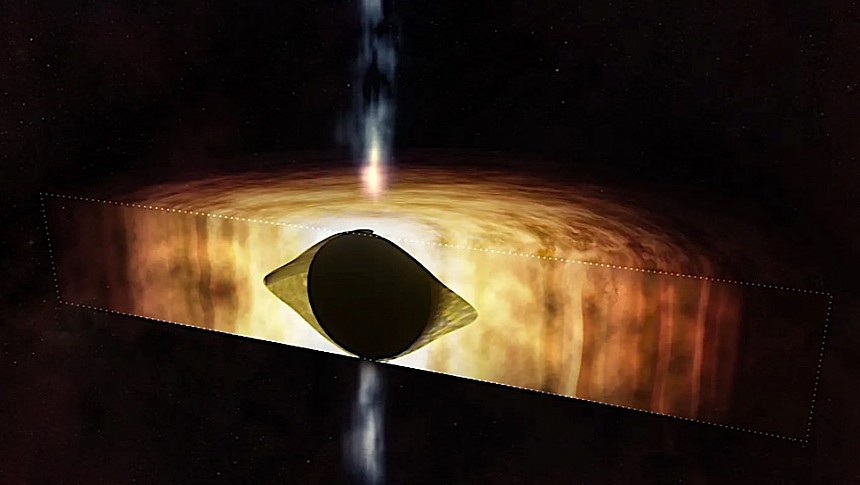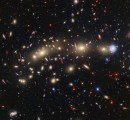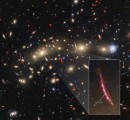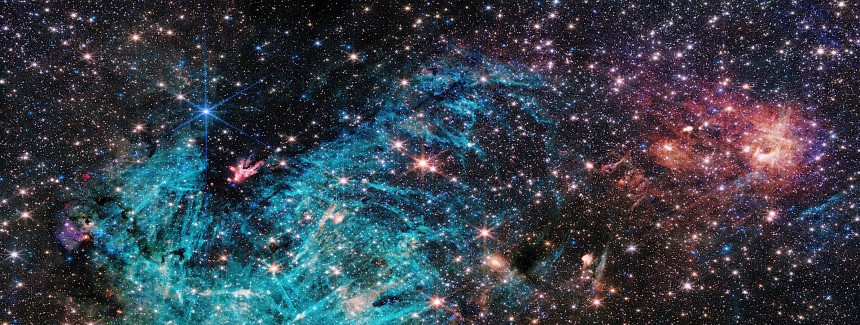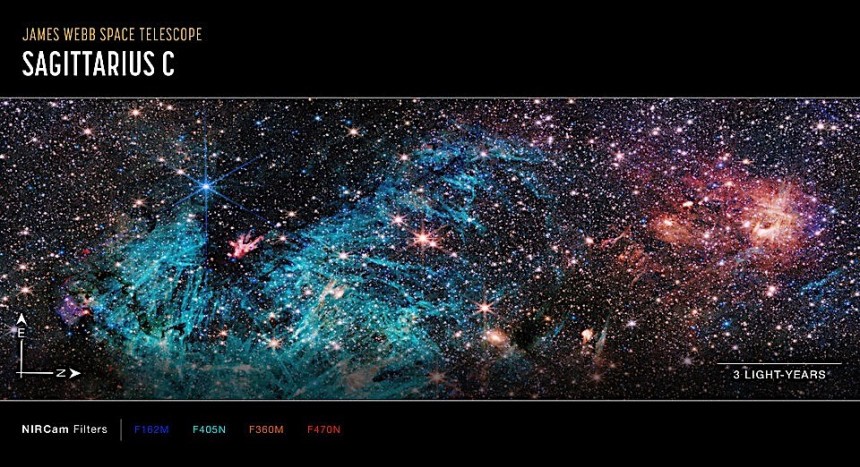There's this thing happening to humans called pareidolia. That's the tendency of the human brain to find a meaningful interpretation to the things our senses perceive. Most often, that translates into seeing familiar shapes, patterns and meanings where there actually aren't any. Like, say, seeing the oval shape of a football at the center of our own galaxy on the eve of the Super Bowl.
Super Bowl LVIII takes place on February 12 and will see the Kansas City Chief facing off against the San Francisco 49ers at Allegiant Stadium in Las Vegas, Nevada, a relatively new arena (it was completed in 2020) that can hold as many as 72,000 people.
As it usually happens this time of year, all of America, businesses and people alike, come together in a mammoth celebration of all things football, each scrambling to mark the moment the best way they can.
Because of the nature of its activities, NASA has few ways it can connect itself to sports event, but that doesn't mean it doesn't try, and at times, it gets really creative in its attempts. Like this year, when it more or less said it found a black hole called Sagittarius A (Sgr A) playing with a football.
Sagittarius A is the supermassive black hole at the center of our Milky Way galaxy, a place located 26,000 light years from Earth that is 4.3 million times larger than the Sun in terms of mass. Like all space objects of its kind, it eats light and drinks time.
How much light and matter such things eat and how much time they drink depends greatly on how fast a black hole spins. When it comes to our own massive space object, scientists are divided: some say the thing does not spin at all, while others claim it spins close to the maximum rate: that is the limit of the speed of light, which, as far as we know, no matter is capable of reaching.
The difference resulted from the use of various observation and science methods. A brand new one, which relies on X-ray and radio data to determine the speed of the black hole's spin, says Sagittarius A is spinning at an angular velocity (revolutions per second) of 60 percent of that maximum limit.
One can easily picture what a spinning black hole does: it pulls in spacetime itself, along with all the nearby matter, squashing everything down as it does this. This results in the spacetime around the black hole, when observed from the side, looking like a football that gets flatter and flatter as the rate of the spin increases.
One could argue NASA chose the perfect timing to announce the discovery surrounding the spin rate of Sagittarius A, given the approaching Super Bowl and all. The team that worked on the project using data from the Chandra X-ray Observatory and the National Science Foundation's Karl G. Jansky Very Large Array (VLA) actually published their findings in Monthly Notices of the Royal Astronomical Society back in January.
The research is important far beyond this rather forced connection to the Super Bowl. Knowing how fast a black hole spins gives us a much better understanding of these objects and their behavior.
Based on the data gathered with this new method, astronomers now say Sagittarius A must have very limited fuel left around it, having devoured pretty much everything long ago. Because of this it doesn't produce a lot of collimated outflows, meaning these jets of material are relatively weak around our own black hole.
But despite its appearance space is a very dynamic place, and the properties of matter around the black hole might change in the future, or the same could happen to the strength of the magnetic field there. That could happen if, for instance, a nearby star is pulled too close to Sagittarius A and devoured by the object's immense forces.
"A spinning black hole is like a rocket on the launch pad," said in a statement Biny Sebastian, a co-author of the research from the University of Manitoba in Winnipeg, Canada. "Once material gets close enough, it's like someone has fueled the rocket and hit the ‘launch' button."
If that happens astronomers expect the spin of the black hole to generate more powerful outflows. They are spectacular, true, but they may seem too far away (after all, 26,000 light-years is a distance impossible to comprehend) to have an effect on us.
Astronomers however say that if Sagittarius A starts generating huge collimated jets, the gas supply for the entire galaxy could be impacted. That, in turn, will affect how fast new stars are formed or, in extreme cases, might even prevent new ones from being born.
If you are into the technical aspects of the research, you can have a look at the paper published in January by researchers from several universities here.
As it usually happens this time of year, all of America, businesses and people alike, come together in a mammoth celebration of all things football, each scrambling to mark the moment the best way they can.
Because of the nature of its activities, NASA has few ways it can connect itself to sports event, but that doesn't mean it doesn't try, and at times, it gets really creative in its attempts. Like this year, when it more or less said it found a black hole called Sagittarius A (Sgr A) playing with a football.
Sagittarius A is the supermassive black hole at the center of our Milky Way galaxy, a place located 26,000 light years from Earth that is 4.3 million times larger than the Sun in terms of mass. Like all space objects of its kind, it eats light and drinks time.
How much light and matter such things eat and how much time they drink depends greatly on how fast a black hole spins. When it comes to our own massive space object, scientists are divided: some say the thing does not spin at all, while others claim it spins close to the maximum rate: that is the limit of the speed of light, which, as far as we know, no matter is capable of reaching.
The difference resulted from the use of various observation and science methods. A brand new one, which relies on X-ray and radio data to determine the speed of the black hole's spin, says Sagittarius A is spinning at an angular velocity (revolutions per second) of 60 percent of that maximum limit.
One could argue NASA chose the perfect timing to announce the discovery surrounding the spin rate of Sagittarius A, given the approaching Super Bowl and all. The team that worked on the project using data from the Chandra X-ray Observatory and the National Science Foundation's Karl G. Jansky Very Large Array (VLA) actually published their findings in Monthly Notices of the Royal Astronomical Society back in January.
The research is important far beyond this rather forced connection to the Super Bowl. Knowing how fast a black hole spins gives us a much better understanding of these objects and their behavior.
Based on the data gathered with this new method, astronomers now say Sagittarius A must have very limited fuel left around it, having devoured pretty much everything long ago. Because of this it doesn't produce a lot of collimated outflows, meaning these jets of material are relatively weak around our own black hole.
But despite its appearance space is a very dynamic place, and the properties of matter around the black hole might change in the future, or the same could happen to the strength of the magnetic field there. That could happen if, for instance, a nearby star is pulled too close to Sagittarius A and devoured by the object's immense forces.
If that happens astronomers expect the spin of the black hole to generate more powerful outflows. They are spectacular, true, but they may seem too far away (after all, 26,000 light-years is a distance impossible to comprehend) to have an effect on us.
Astronomers however say that if Sagittarius A starts generating huge collimated jets, the gas supply for the entire galaxy could be impacted. That, in turn, will affect how fast new stars are formed or, in extreme cases, might even prevent new ones from being born.
If you are into the technical aspects of the research, you can have a look at the paper published in January by researchers from several universities here.
